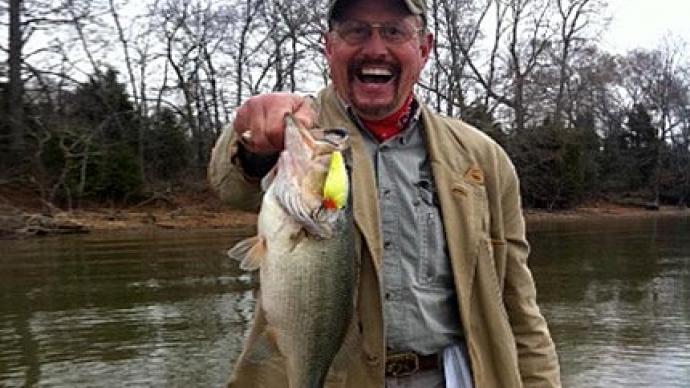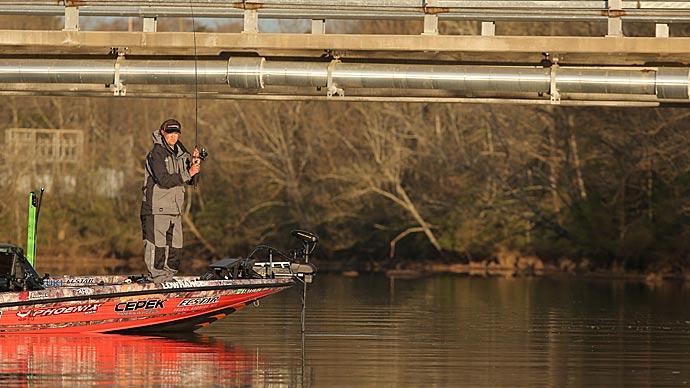
Yea, the spawn is over. The "sight" fishing folks have had their fling, and the warm water means more aggressive bass. The more aggressive bass are those with greater strike zones, the more readily willing to chase forage. This plays into the strengths of crankbaits. These baits, as a category, are plugs designed to cover more water in a shorter period than the more slowly worked soft plastic and jig-n-pig combinations.
The two types of baits complement each other in that you can work located schools for longer periods once they have been found using a worm or soft plastic, but the catch is you have first to find the schools.
There are some facets of crankbait fishing that you have to accept if you buy into this type of fishing. To begin with, you are going to exert a lot of energy. Worm fishing is your thing if you do not want to do this. However, the fact that you are constantly casting and winding can be an asset when trying to get a youngster or a new beginner into bass fishing because something is going on with each cast of a crankbait.
Your choice of tackle is essential to get the best out of your crankbaits. You first have to choose the pound test line you wish to use. This is a significant decision because there are trade-offs in using heavier and lighter lines for cranks. The advantage of heavier lines is that you have a better chance of getting your crank back if you hang up in the brush. The downside with heavier lines is that you do not get the maximum depth of a diving crankbait on a given retrieve rate. The fact is that when you look at many of the deeper crankbait boxes, you will see the dive rating was achieved for a given pound test. The thinner the line (lighter pound test), the deeper you can "drive" a crankbait on retrieve since you have much less resistance to the line cutting the water than you will with a heavier pound test (thicker) line.
Yet as a friend pointed out, some of the folks in a nationally televised tournament said they were using lighter line and fishing deep cranks. In a minute, he realized they were getting their baits and line from the event holders. So I would offer a parting shot about the line by noting that given good drag systems on most of the better reels, you can get by with light line and still get in good fish if you are in water that offers little hang-ups. But if you are fishing in the thicker brush that etches the line or you will hang up a lot, you will lose both fish and cranks with light line.
To properly fish crankbaits, you need a good reel. A few years ago, the reel offered by one company was dubbed a "crankbait" reel and offered a slow retrieve. I was at company events where this and other models were being introduced to some of us who were loosely dubbed as field staff. It offered just the opposite of what I felt was an ideal reel for crankbait fishing. I would not use anything other than a 6.3:1 or greater retrieve ratio. The logic is simple. Think of the reel in terms of a high-power outboard. If you want to open it up, you have the power. You can run it at three-quarter throttle if you want peak fuel efficiency. Sometimes you want the reel to allow you to reel in the line faster, such as working a sinking crankbait over cover or grass. Likewise, you sometimes want to "burn" the lure back and drive a diving crankbait down to the maximum depth as soon as possible on your retrieve. A low-ratio reel will not let you do either. Interestingly, the slow "crankbait" reel is now a collector item since not many wanted its attributes.
Another thing I neglected to mention as to an advantage of faster retrieve reels as applies to cranks is that you can more easily take up the slack and thus control the hooked fish. Most bass get off when there is slack, or a loss of pressure applied during the retrieve.
Another issue to consider when purchasing a reel is the type of handle. It should be long enough to permit you to easily apply pressure over a long period without discomfort. Only you can determine if you prefer a round or a flat surface on the handle. Still, you indeed have to decide what is most comfortable for you because, unlike with working any other type of bait, you will be holding on tight during the entire retrieve.
The following important tool in crankbait fishing is the rod. The most desirable rod for crankbait fishing has become somewhat of a party line. Several folks over the last few years have advocated a "softer" backbone rod to better permit the absorption of the strike and give with the fish more readily, thus preventing the loss of fish due to too much pressure. Many companies have offered a fiberglass model billed as a crankbait rod. I have a different concept as to the ideal rod for crankbait fishing. A few years ago, I gratefully gave up my last fiberglass rod and replaced it with the more sensitive and much lighter graphite rod. The newer crankbait rods have the same parabolic bend and achieve the same objective while providing more sensitivity than fiberglass.
Everyone would agree that the ideal rod for cranking should be at least 7 feet. The other point is that preserving your shoulder and wrist is very important to learn how to two-hand cast with a trigger-stick straight handle rod. Not only do these rods keep you from being so tired and developing sore joints, but also, by distributing the workload, the longer handle allows you to have greater leverage to counterbalance the pressure of a hard-pulling crankbait on the retrieve.
Another piece of advice for a crankbait fisherman is to use a snap as a connector to the lure. This gives most crankbaits an extra pivot point and lets them "swim" with more action. The only time that another option may be necessary is with some of the balsa jerkbaits, which are very light. In those cases, I suggest using a loop knot that achieves the same objective by allowing the bait minimum restriction on its swimming action. In selecting a snap, you can get a good idea of the strength printed on the package providing a pound test. If not, then at least select snaps that interlock when closed. You do not want to get a snap that is overkill and too large for what is necessary to do the job. The other real advantage of a snap is that you can change baits quickly and get the lure back in the water for more casts. The best crankbait fishermen use a machinegun approach to keep the lures out of the boat as much as possible. One preference in choosing a snap is to use one with a black color. If you look at the bait in the water, it is evident that the black snap quickly disappears as part of the silhouette of the plug and is not a visible distraction. There is no need for a swivel in combination with a snap when using crankbaits since even the quality spinnerbaits on the market today track true, and there is no line twist on the retrieve.
There are two types of crankbaits to consider for bass fishing. These are the plugs that sink when hitting the water, and the other category are the baits that float and dive to some depth during the retrieve. The sinking cranks are versatile since they can be worked at shallow depths on the more rapid retrieve or fished at greater depth by simply allowing the plug to fall to a given depth using a countdown technique. The chief models, which fall into this category, are the lipless swimming baits, spinnerbaits, and tail-spin plugs. The lipless plugs started with early versions, such as the Heddon Sonic but were refined by Cordell in his Hot Spot bait. A whole new twist was added by the folks at Rat-L-Trap, who added a rattle system, so the vibration of a wiggling bait was complimented by a noise release each time the pellets hit the side of the plug.
There are few major companies and most smaller companies with similar plugs in their line of products. Their popularity is not surprising since these baits will catch fish if you throw and wind. Add a slight variation using a countdown style of fishing and variations in the retrieve rate, and you get all sorts of presentations with the same plug. Any crankbait is best as a fish attractor if you realize you can use it to make different presentations. Certainly, bass, on some days, will seemingly strike an old shoe, but on others, respond to very selective presentations.
The spinnerbait is a plug that anyone can work, and the other beauty is that when they are controlled at the point of entry into the water and as you begin to retrieve the bait, they become essentially weedless. The weedless part is no small matter when using a crankbait because bass relate to cover, and if you get them to strike, you need to cast where they are holding.
Bass fishermen often overlook the third type of sinking crankbait. This is the tailspin type of plug. There are some downsides to using these lead head plugs, including they hang up easily, so you are almost required to use them in more open water. The next downer is that a thrashing bass more easily throws them than most other cranks. The counter to this is that bass actively feeding on shad love these baits.
The crankbaits that float at rest and dive on retrieve have their particular niche as fish producers. They all have various types of lips, which trap the water, but how they react on retrieve may vary significantly. Two similar-appearing baits may have different dive angles and running depths on the retrieve. Each may also have a much different action on retrieve. Some may have a tight wiggle, and others with a wider lip have a less rapid dive rate and a greater water displacement with each wide wiggle. In other words, the latter may not come forward as rapidly when you apply the same retrieve rate with the reel because of the physics involved in water displacement.
When can this be a helpful thing? To begin with, a slower-moving and wider wobbling action is useful when fish may be less aggressive feeders. You are simply keeping the bait in front of the bass longer. The other natural advantage to a slower wobble and slower-moving bait is in stained or murky water. The displacement of the water sends out even more vibrations, which the bass can hone in to find a potential food source.
Crankbaits and summer go together in that the bass are more prone to be on the move. This is where cranks are at their best, being used to eliminate areas or establish productive areas. When this is combined with the ability to establish patterns more rapidly, you have a real leg up on the game of working out the challenge of catching summertime bass.




